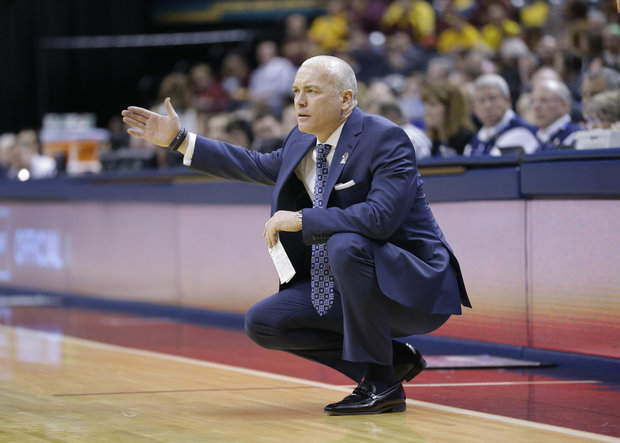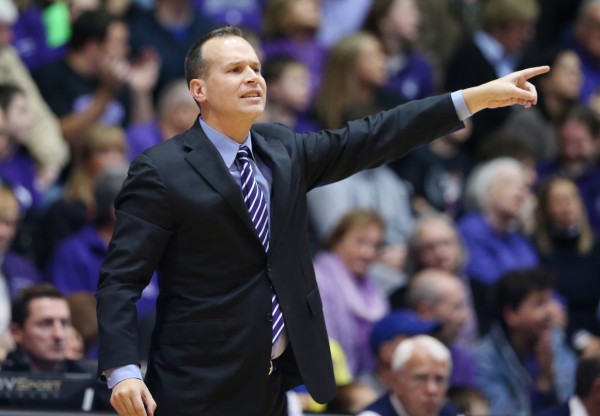Big Ten Key Offseason Questions: Part II
Posted by Patrick Engel on April 7th, 2016Part one of our four-part review of each Big Ten team examined key questions for the league’s bottom three finishers: Rutgers, Minnesota and Illinois. Part two tackles important offseason questions for Penn State, Nebraska and Northwestern. (note: Scout.com used for all player and class ranks).
Penn State (16-16, 7-11 Big Ten)

Pat Chambers signed the highest-rated recruiting class in Penn State history, but will it net immediate results? (AP Photo/Michael Conroy).
Can the best recruiting class in program history bring immediate results?
Penn State signed a top-20 recruiting class that includes top-40 overall point guard Tony Carr, top-75 overall wing Lamar Stevens, three-star wing Nazeer Bostick and three-star center Joe Hampton. It comes on the heels of a 2015 class that included four-star wing Josh Reaves – who showed great promise in 19 starts as a freshman — and big man Mike Watkins, who had to sit out the year with academic issues. How quickly can all these young players make an impact? Carr is a natural point guard, a good transition player and passer who can get into the paint and find quality shots. He’s not known for long-range shooting, but he’s good enough that head coach Pat Chambers could move Shep Garner off the ball. At 6’6″, Stevens is a hybrid forward in the mold of former Maryland star Dez Wells. He should fit well in the Brandon Taylor role for the Nittany Lions. Penn State’s post offense was a significant weakness this year, but with two of its three centers finishing their careers, Watkins and Hampton will have an opportunity to produce. A potential starting five of Carr, Garner, Reaves, Stevens and Watkins, Hampton or junior Julian Moore is a very good lineup on paper. But the young stars will need to adjust right away for Penn State to finish higher than 10th in the Big Ten for the first time under Chambers.
Nebraska (16-18, 6-12 Big Ten)
Can the Huskers’ offense take yet another step forward without Shavon Shields?
Nebraska fans were feeling pretty good on January 20. The Huskers had just beaten Michigan State in East Lansing for their fourth straight win and were 4-3 in conference play. Things took a dive from there, however, as they proceeded to win just two of their final 11 games. Within that slump was a five-game losing streak in which the team failed to top a point per possession even one time. Despite those struggles, the offense finished 88th nationally in adjusted efficiency (108.3, per KenPom), which is 197 spots better than the 2014-15 team’s finish. If the Huskers want to take another step forward, they will have to do so without forward Shavon Shields, the team leader in scoring (16.8 PPG), assists (2.7 APG) and usage (29 percent of his team’s shots). Fortunately, Andrew White (16.6 PPG, team-best 48.1% FG) returns, and guard Anton Gill, a former top-50 recruit, is also eligible after sitting out this season after his transfer from Louisville. Others such as skilled but streaky guard Tai Webster need to both score and take care of the ball more consistently — the junior contributed eight games with at least 15 points, but also eight with five or fewer; he also turned the ball over on 21.5 percent of possessions. Glynn Watson Jr. should take over as point guard as Benny Parker departs. His low turnover rate (11.8%) is impressive, but he needs to avoid the pull-up, unassisted jumpers (39% FG) that he took far too often this season. Nebraska’s bench depth should come from four-star freshman wing Isaiah Roby, sophomore guard Bakari Evelyn and sophomore forwards Ed Morrow and Jack McVeigh.
Northwestern (20-12, 8-10 Big Ten)
Just how much progress did the Wildcats make last year?
Northwestern won 20 regular season games and improved to 8-10 in Big Ten play. That may look like some progress, and it was probably Chris Collins’ best team, but those 20 wins were earned against an extremely soft schedule. Northwestern was 12-1 entering Big Ten play but its non-conference strength of schedule ranked a paltry 334th nationally, as 10 of those wins came against teams ranked 182nd or worse. After a 2-8 stretch to open Big Ten play, the Wildcats put together an 8-10 Big Ten record, an improvement of two games over Collins’ first two seasons. Of those eight Big Ten wins, however, only one came against a top-50 team, the same number as a year ago. That win total, while impressive at first blush, ultimately comes off a little empty. Northwestern brings in another good freshman class next season, led by four-star wing Rapolas Ivanauskas. The Wildcats should also get forward Vic Law back after missing this season with a shoulder injury. Point guard Bryant McIntosh had an All-Big Ten caliber season and center Dererk Pardon scored 28 points in his first career game. The roster is as good as any in school history, but will it play and win more meaningful games next year?










































